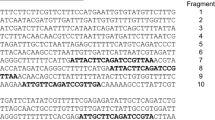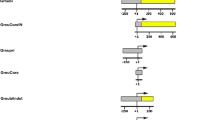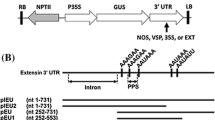Abstract.
An intron-containing β-glucuronidase (GUS) gene has been used widely in promoter analyses and as a plant transformation marker. Maximal plant gene expression requires accurate and efficient removal of the intron from the expressed pre-mRNA transcripts by splicing. Detailed analysis of splicing of potato ST-LS1 and pea legumin introns from GUS constructs revealed the activation of a cryptic 5′ splice site in the GUS coding sequence 4 nt upstream from the authentic intron 5′ splice site. About 40% of transcripts utilised the cryptic 5′ splice site in tobacco protoplasts, reducing the translational potential of expressed pre-mRNA. The same cryptic splicing event was evident in transgenic tobacco leaves but at reduced levels. Mutations that removed the cryptic 5′ splice site are associated with a two-fold enhancement in GUS activity in tobacco protoplasts, highlighting the need for careful examination of introns and their sites of insertion into gene constructs to minimise variability in gene activity and maximise gene expression.
Similar content being viewed by others
Author information
Authors and Affiliations
Additional information
Electronic Publication
Rights and permissions
About this article
Cite this article
Ibrahim, A., Watters, J., Clark, G. et al. Expression of intron-containing GUS constructs is reduced due to activation of a cryptic 5′ splice site. Mol Gen Genomics 265, 455–460 (2001). https://doi.org/10.1007/s004380000433
Received:
Accepted:
Published:
Issue Date:
DOI: https://doi.org/10.1007/s004380000433




